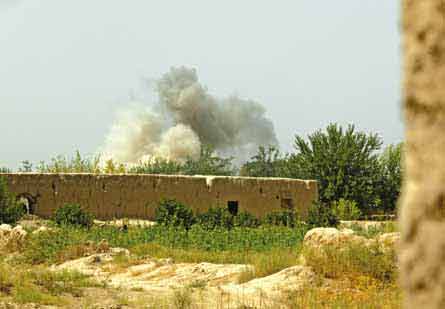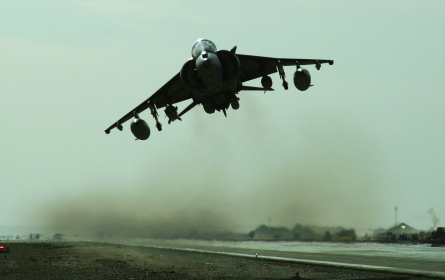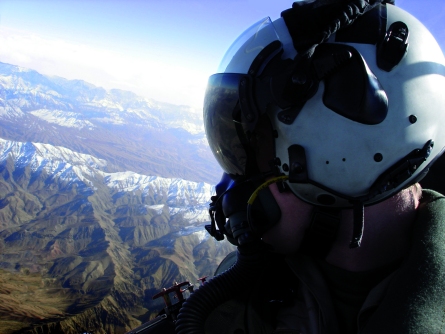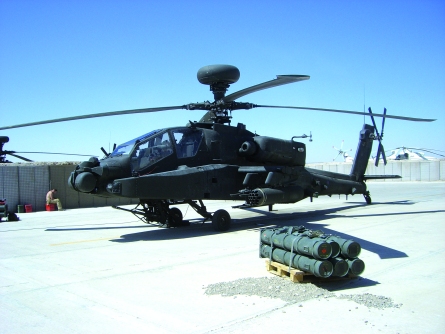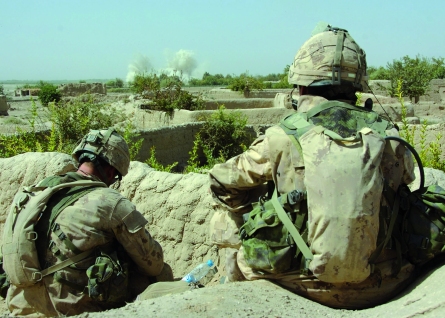Renewed conflict in Afghanistan has seen NATO launch its largest air offensive since Kosovo, but with a focus on providing close air support to troops
From the middle of this year, troops of NATO's International Security Assistance Force (ISAF) found themselves locked in heavy fighting across southern Afghanistan against several thousand Taliban insurgents and their militia allies. As the fighting escalated, small groups of isolated and outnumbered NATO troops began calling on increasing amounts of air support to keep the enemy at bay.
| |
|---|
ISAF troops have relied heavily on precision air strikes |
Fixed-wing strike aircraft operated by the Dutch, French, UK and US armed forces participated in these operations, making the Afghan mission the alliance's biggest air campaign since the 1999 Kosovo conflict. The Afghan fighting reached a climax in September, when more than 1,000 close air support sorties were flown by NATO fixed-wing combat aircraft, as alliance troops launched Operation Medusa to destroy a concentration of 1,000 Taliban fighters massing to attack Kandahar city. In the course of four months of fighting, its aircraft dropped and fired more than 1,200 bombs and rockets across southern Afghanistan. Dutch, UK and US attack helicopters used even more missiles, rockets and cannon fire.
Fighting was equally intense in neighbouring Helmand, where 160 air strikes were employed in August. One hundred of these were used to keep Taliban fighters from overrunning Danish, UK and US troops besieged in Musa Qalah.
UK Royal Air Force officers based at Kandahar airfield describe the recent operations as a "classic close air support" battle, and say the British armed forces have not experienced anything quite like it since the Normandy campaign in the Second World War.
While the intensity of the fighting has been unprecedented, UK and other NATO airmen in Afghanistan say the operations have been very different to the air campaigns conducted in the Balkans in the 1990s, the first Gulf war and the initial stages of the second Gulf war.
These were coercive strategic operations - using the complete range of air power roles - aimed at the governments of hostile states in Afghanistan, NATO air power has been used almost exclusively to support land forces fighting close quarters battles against small groups of Taliban fighters.
Finding the target
The Afghan air campaign has revolved around what the RAF and British Army term "air/land integration", with ground controllers deployed alongside frontline army units to direct air strikes against Taliban targets. This is the other end of the spectrum to Strategic Air Operations, where the use of air power is directed from Combined Air Operations Centres, with senior officers, and sometimes government leaders, approving targets for attack.
According to Wg Cdr Ian Duguid, commander of UK's BAE Systems Harrier GR7A detachment at Kandahar, it is impossible to pre-plan missions on the Afghan battlefield. His pilots do not know their targets before they take off and have to await calls for help from troops in contact with Taliban fighters before being assigned to specific targets. UK Harriers flew almost 250 sorties in September, dropping almost 70 Raytheon Enhanced Paveway II precision-guided bombs, 245kg (540lb) and 450kg freefall bombs and firing more than 400 CRV-7 unguided rockets (see table P32).
The main contingent of UK ground forces, under the command of 16 Air Assault Brigade, were deployed in Helmand province in late May, supported by several Tactical Air Control Parties (TACP), which are also known as forward air controllers or Joint Terminal Attack Controllers (JTAC). The latter term is the US designation, which was adopted after the Iraq conflict three years ago when the US Air Force, Army, Marine Corps and Navy standardised their forward air control organisations, but NATO forces are also increasingly using the term.
The TACP/JTACs comprise four- to-six man teams of personnel qualified to provide radio communications, select targets and direct fixed wing air strikes. They boast a variety of night vision, laser range finding/pointing and communication equipment, all of which must be "man portable" by rucksack, for use by JTACs operating with infantry or Special Forces units in Afghanistan.
At any given time, 16 Brigade has about a dozen JTACs operating in its area of responsibility, including the three organic brigade JTAC parties drawn from the RAF Regiment and Parachute Regiment, as well as Canadian, Danish and US Army teams qualified JTAC teams from the Household Cavalry's armoured reconnaissance squadron and 16 Brigade's Pathfinder Platoon.
UK, US and other NATO Special Forces units that contain a high number of JTAC qualified personnel also operate in Helmand on occasions. 16 Brigade has a peacetime establishment of three TACP/JTAC teams, one of which is routinely assigned to support an infantry battalion, but the brigade took all three to support the single battalion of paratroopers deployed to Afghanistan.
To further increase flexibility, 16 Brigade combined its JTACs with army artillery and mortar fire controllers to create multi-skilled groups known as Fire Support Teams (FST).
The JTACs available in Afghanistan also contain a range of capabilities, with the US teams being the best equipped. Their ground controllers can view imagery from General Atomics Predator unmanned air vehicles and Fairchild A-10 ground-attack aircraft - the latter equipped with Northrop Grumman Litening AT targeting pods - in real time on their laptops.
|
|---|
UK Harriers have flown numerous close air support missions from Kandahar |
Rules of engagement
Because the fighting in Afghanistan has largely been at close proximity, Alliance rules of engagement require that any targets for close air support are to be selected and authorised by a JTAC before weapons can be released. These are long-standing arrangements to guard against friendly fire incidents that stretch back to the Second World War, but in Afghanistan these rules of engagement are also intended to minimise civilian casualties and damage to civilian property.
NATO UAVs and other strategic intelligence-gathering systems are used extensively to find high value or time sensitive targets. If no Alliance JTACs are within sight of a target, complex procedures to clear weapons release come into force. This requires multiple sensor coverage of the target, and authority to engage from a senior officer in the NATO brigade headquarters in Kandahar or Kabul, depending on the collateral damage implications.
UK paratroopers operating in Helmand province relied heavily on JTACs to bring in air support during their defence against a series of attacks on Afghan government district headquarters compounds from June to September.
Day after day, JTAC teams in each district compound would call for air strikes against Taliban mortars, rocket launchers and snipers. The 16 Brigade also deployed a number of manoeuvre groups with accompanying JTACs in order to disrupt efforts by Taliban fighters to co-ordinate attacks on isolated UK outposts, or to secure resupply road routes.
JTACs became integral parts of the beleaguered UK contingents and regularly acted as a link to fixed-wing aircraft and attack helicopters, both of which were often used as high-flying "eyes in the skies" to seek out Taliban fighters concealed behind hills or within walled compounds, in an example of non-traditional intelligence and surveillance.
Even with this significant provision of JTACs, Brig Ed Butler, Commander of 16 Brigade and the UK Task Force in Helmand, told Flight International: "We don't go out of our bases without JTACs." He says only having 12 JTACs "limited my manoeuvres - we could have doubled them". They should also be manned by "capable and committed people", he says.
Before its deployment to Afghanistan, the brigade had developed a technique known as Close-In Fire Support (CIFS) to make it easier to call for attack helicopter support. According to British Army Boeing/Westland Apache AH1 attack helicopter crews, CIFS is a middle ground between an artillery fire mission and formal close air support by fixed-wing aircraft.
"It is available to any soldier on the radio net," said an Apache pilot during the brigade's pre-deployment training. "You do not need to be a qualified forward air controller to call for CIFS. It involves an Apache flying behind the assault infantry wave and putting down fire over the heads of the troops as requested."
Apache experience
Five months into the Afghanistan operation, Apache crews from the UK's 9 Regiment Army Air Corps say they have only occasionally had to use the CIFS technique to defend British positions. "In district compounds they have JTACs and they call us in," says one officer.
"We used CIFS in one operation when the Paras were moving through the area flushing guys out. They came up on the radio net asking us to engage the enemy in a wood line, and it does work. The enemy run when we appear. If they don't and are seen, they go to pieces - literally."
|
|---|
The recent heavy fighting - and subsequent criticism of the RAF's performance from some army officers - has prompted the services to revisit how they organise and execute air/land integration at all levels of command.
UK chief of the air staff Air Chief Marshal Sir Glenn Torpy visited Kandahar in September to view the progress of the NATO air campaign first hand. "We have done a huge amount of work on air/land integration, building on previous experience in Kosovo, Afghanistan and Iraq, but we have to continuously look at how we conduct our business," he told Flight International.
"We are good at providing reactive close air support to troops under attack, but we also need to ensure that we make the best use of air power in the planning, preparation and execution phases of land combat operations." This is now being addressed in a high-level assessment exercise co-sponsored by Torpy and Gen Sir Richard Dannatt, chief of the general staff, which will culminate in a joint RAF-Army conference next year.
Torpy says his initial impression is that the issues identified during his visit were less about equipment and more about processes and people. "I am taking a personal interest in getting the right people in key positions to provide the support our land forces require." He is also looking to boost RAF involvement in army pre-deployment training exercises. "A lot needs to be done."
Other RAF officers at Kandahar say that sustained effort is needed to better educate and inform army commanders and planning staffs about what are termed "non-kinetic effects" to shape events on the ground, before battle is joined and weapons need to be employed.
|
|---|
The British Army is honing the use of its Apache attack helicopters |
These could range from using non-traditional assets, UAVs and photographic reconnaissance to detect the presence of Taliban fighters, to the liberal use of jet noise to deter village militia from siding with more hard-line elements. They are also keen to re-equip the UK's Harriers with a new targeting pod, which would dramatically enhance the type's ability to support troops on the ground. Improving the training and experience of staff officers working in air support operations centres in divisional and corps headquarters is also a key priority, they say.
According to Butler, "a fundamental change of mindset" is needed to better integrate air and land operations. He says assets such as fixed-wing strike aircraft, UAVs and photographic reconnaissance platforms which are normally controlled by divisional headquarters "are now in the hands of battlegroups we are talking about small groups of men".
"This has got to be the way to go," he adds. "The question is how we push down to battlegroup level - training is critical."
Lessons learned
The air and land components also need to forge a closer long-term relationship, Butler believes. "They need to live, breath and exercise together on a regular basis. The more we can do jointly at battlegroup level, the better." Butler says he has an eight-person strong air planning/operations cell in his headquarters, which is the British Army's only air manoeuvre formation.
Pushing forward more personnel trained to call in close air support to the front line is a high priority for the UK armed forces. The Royal Marines and the Royal Artillery have merged their TACPs assigned to 3 Commando Brigade with the artillery, naval gunfire and mortar fire control teams to form FSTs.
These cross-qualified teams are now in Afghanistan with 3 Commando Brigade and its follow-on formation. The 12 Mechanised Brigade has formed its own FSTs ready for its deployment next May. The latter unit has already held a major air support exercise in Arizona, involving its fire control personnel, Apaches from the British Army's 3 Regiment and USAF A-10 ground-attack aircraft.
This year's heavy activity in Afghanistan has stimulated much debate within the British armed forces - and the nation's media - on future air/land integration concepts, procedures and equipment requirements.
With the conflict in Afghanistan likely to continue for the next few years this is not an academic debate, but one of the most pressing issues now facing the RAF and the British Army.
|
|---|
Ground controllers play a vital role in coalition air strikes |
Source: Flight International





















